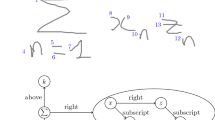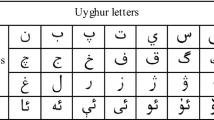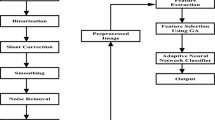Abstract
In this paper we introduce a new hybrid system for the automated recognition of hand-written characters — we combine the most promising approaches of the last decade, i.e., neural networks and structural/ syntactical analysis methods. The given patterns represent handwritten capital letters and digits stored in arrays. The first part of the hybrid system consists of the implementation of a neural network and yields a rapid and reliable pre-selection of the most probable characters the given pattern may represent. Depending on the quality and the special characteristics of the given pattern a flexible set of characters is communicated to the second part of the hybrid system, the structural analysis module. The final decision is based on the evaluation of the presence of features, being characteristic for a specific character, in the underlying pattern. Basically, the structural analysis module consists of graph controlled array grammar systems using prescribed teams of productions. We describe the main parts of the implemented hybrid system and demonstrate the power of our approach.
Chapter PDF
Similar content being viewed by others
References
H. Arnold, Erkennung von handgeschriebenen Buchstaben mittels Entscheidungsstrategie, Neuraler Netze und BP-Untergruppen, Thesis, Technical University Vienna, 1994.
C.M. Bishop, Neural Networks for Pattern Recognition, Clarendon Press, Oxford, 1995.
C.R. Cook and P.S.-P. Wang, A Chomsky hierarchy of isotonic array grammars and languages, Computer Graphics and Image Processing 8 (1978), pp. 144–152.
J. Dassow and Gh. Păun, Regulated Rewriting in Formal Language Theory Springer, Berlin, 1989).
H. Fernau, R. Freund, and Markus Holzer, Regulated array grammars of finite index, Part I: Theoretical investigations. In: Gh. Păun and A. Salomaa (eds.), Grammatical Models of Multi-Agent Systems, Gordon and Breach, Reading, UK, 1998.
H. Fernau, R. Freund, and M. Holzer, Character recognition with k-head finite automata. In: A. Amin, D. Dori, P. Pudil, H. Freeman (eds.), Advances in Pattern Recognition (Proceedings SSPR’98) (Springer, Berlin, 1998), pp. 282–291.
L. Heutte, J.V. Moreau, T. Paquet, Y. Lecourtier, and C. Oliver, Combining Structural and Statistical Features for the Recognition of Handwritten Characters, Proceedings of the thirteenth international Conference on Pattern Recognition, Vol. 2, pp. 210–214, ed. IEEE Comp.Soc., IEEE Comp.Soc. Vienna, Austria, 1996.
M. Neubauer and M. Summerer, Character recognition based on structural feature detection using array grammar systems, Thesis, Vienna University of Technology, 1999.
Gh. Păun and G. Rozenberg, Prescribed teams of grammars, Acta Informatica 31, 6 (1994), 525–537.
A. Rosenfeld, Picture Languages (Academic Press, Reading, MA, 1979).
J. H. Sossa, An improved parallel algorithm for thinning digital patterns, Pattern Recognition Letters 10 (1989), pp. 77–80.
P. S.-P. Wang, Some new results on isotonic array grammars, Information Processing Letters 10 (1980), pp. 129–131.
P. S.-P. Wang, An application of array grammars to clustering analysis for syntactic patterns, Pattern Recognition 17, 4 (1984), pp. 441–451.
Y.Y. Zhang, P.S.P. Wang: A Parallel Thinning Algorithm with Two-Subiteration that Generates One-Pixel-Wide Skeletons, Proceedings of the thirteenth international Conference on Pattern Recognition, Vol. 4, pp. 457–461, ed. IEEE Comp.Soc. IEEE Comp.Soc., Vienna, Austria, 1996.
Author information
Authors and Affiliations
Editor information
Editors and Affiliations
Rights and permissions
Copyright information
© 2000 Springer-Verlag Berlin Heidelberg
About this paper
Cite this paper
Freund, R., Neubauer, M., Summerer, M., Gruber, S., Schaffer, J., Swoboda, R. (2000). A Hybrid System for the Recognition of Hand-Written Characters. In: Ferri, F.J., Iñesta, J.M., Amin, A., Pudil, P. (eds) Advances in Pattern Recognition. SSPR /SPR 2000. Lecture Notes in Computer Science, vol 1876. Springer, Berlin, Heidelberg. https://doi.org/10.1007/3-540-44522-6_7
Download citation
DOI: https://doi.org/10.1007/3-540-44522-6_7
Published:
Publisher Name: Springer, Berlin, Heidelberg
Print ISBN: 978-3-540-67946-2
Online ISBN: 978-3-540-44522-7
eBook Packages: Springer Book Archive





